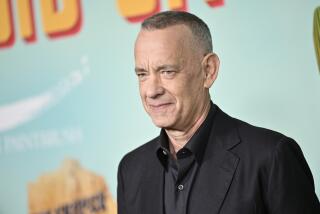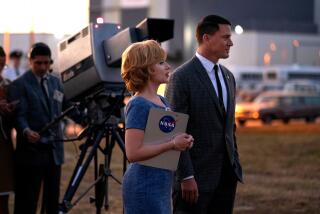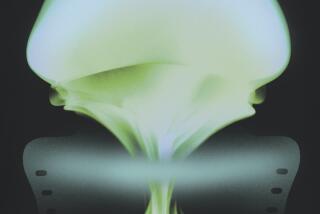Aboard the Star Ship : From ‘Splash’ to ‘Gump,’ Tom Hanks Looks Back at Roles, Politics and Ahead to ‘Apollo 13’
HOUSTON — The moon mission that turned into a nightmare for astronauts Jim Lovell, Fred Haise and Jack Swigert was a dream come true for Tom Hanks.
But, then again, the Apollo 13 astronauts were on board a crippled spacecraft that might have burnt to a crisp while re-entering the Earth’s atmosphere, or simply drifted into oblivion somewhere in the unforgiving blackness of space. The worst risk facing Hanks during the filming of “Apollo 13” was a roller-coaster ride aboard a training KC-135 aircraft that generates weightless conditions affectionately dubbed the “Vomit Comet.”
A small price to pay, Hanks says, for getting the chance “to get dressed up in all those cool uniforms and spacesuits” while playing Lovell, a man he considers nothing less than a genuine American hero.
Lovell (in collaboration with journalist Jeffrey Kluger) wrote “Lost Moon,” a gripping account of the 1970 lunar flight that earned the dubious distinction of being NASA’s most successful failure.
Director Ron Howard has turned Lovell and Kluger’s nonfiction book into “Apollo 13,” a $52-million extravaganza that features a top-billed Hanks as Lovell, the mission’s commander, Bill Paxton as Haise and Kevin Bacon as Swigert.
Also figuring prominently in the Universal Pictures release: Gary Sinise as Ken Mattingly, the astronaut who was bumped from the Apollo 13 flight crew as a health risk (he’d been exposed to measles), then later helped figure a way to get the astronauts back to Earth; Kathleen Quinlan as Marilyn Lovell, the commander’s understandably anxious wife; and Ed Harris (yes, John Glenn of “The Right Stuff”) as Gene Kranz, the Mission Control flight director.
While promoting “Apollo 13” during a recent press gathering here, Hanks graciously attempted to dim his own star power. “Apollo 13,” he insisted, is an ensemble piece, not a one-man show.
“A movie like this would not exist as a star turn,” Hanks said. “You could do it as a star turn, but that would be unfair. It would be a disservice to the reality of it all.
“It’s like, I love what that pilot who was rescued in Bosnia says: ‘I’m not a hero. I was a rabbit running scared in the bushes. The real heroes are the ones who came over and got me.’ That’s absolutely true. Jim Lovell will say, ‘I’m not the hero. I was just the guy who was up there. I wanted to walk on the moon. I was going to be the most obvious guy. But the real heroes are the ones who were down on the ground, who did all the work to get us back.’ ”
Maybe so. Still, there is little doubt in the minds of William Broyles Jr. and Al Reinert, the screenwriters credited with turning “Lost Moon” into “Apollo 13,” that Hanks’ name above the title is what really gave the project lift-off. (“Actually,” Broyles admits, “we originally wrote it with Kevin Costner in mind, simply because the young Jim Lovell looks just like him.”)
For his part, Hanks sounds like a man who takes his currently incandescent superstardom--after back-to-back Oscars as best actor for “Philadelphia” and “Forrest Gump”--with several grains of salt.
And he realizes that, just as an astronaut might find everything else in his life to be a letdown after walking on the moon, he likely will never be part of anything quite so overwhelming as the phenomenal success of “Forrest Gump.” Even “Apollo 13,” which many insiders predict will be an intergalactic hit, isn’t expected to make anywhere near the same impact.
“But I think I’m smart enough to know that that’s inherent to the process,” Hanks said. “The same way that I know that I’ll never do a movie as good or as celebrated as ‘Forrest Gump,’ I know that I’ll never do a movie as bad as ‘Bonfire of the Vanities.’ I realize that I’ve swung both sides of the spectrum here. . . .
“Look, ‘Forrest Gump’ was great, it was fabulous. It lasted much longer than anybody thought, and brought me a degree of attention that no human being on the face of the planet deserves. But thank goodness, that’s over now.”
But is it, really? Pressed on the subject, Hanks conceded that “Forrest Gump” probably “will live forever, because of video and cable. And, in all honesty, because of the effect it had on people’s lives. For some people, I will be Forrest Gump for the rest of my life. But that’s OK, that’s a good thing. I’ll also be Sherman McCoy (of “Bonfire”) to some people for the rest of my life, too. And that’s all right, too. It’s an even trade-off.”
Indeed, as far as Hanks is concerned, there has been only one real downside to the “Forrest Gump” experience: The insistence of commentators from both sides of the political spectrum that the movie offers a warm-and-fuzzy embrace of conservative ideology.
Hanks is especially miffed by Sen. Robert Dole’s (R.-Kan.) recent attempt to lionize “Forrest Gump” as entertainment that upholds traditional family values. Dismissing “Mr. Dole’s political grandstanding” as “ludicrous,” Hanks wondered: “ ‘Forrest Gump’ is in the forefront of good, quality family films? OK, let’s see. Forrest Gump’s mother slept with the principal of the school so Forrest could go there. I guess that must be forgotten in the course of choosing family films. That and the fact that Forrest fathers a child out of wedlock.”
Hanks, 39, conceded that his view of the Vietnam War--and, more specifically, the depiction of that war in “Forrest Gump”--likely was colored by the fact that “I don’t have the same point of view of somebody who had to live in fear of his [draft] lottery number coming up. . . .
“I remember going to the Selective Service office when I was 18, and they said, ‘Listen, you’re not going to have to do this after the first of the year. So if anybody asks you, just tell them you forgot.’ So, for me, it was never an issue.”
It was during this time that young Tom Hanks was most enchanted by the unambiguous heroics of NASA astronauts. He built scale models of their spacecraft and used them to turn his room into a kind of secular shrine.
“I was aware of the space program from Apollo 7 on,” Hanks said. “I knew what all the flights were doing, I knew where they were going, I knew the crews. I would run home from school to see what happened to Apollo 13.”
During the long wait for the return of the Apollo 13 crew, Hanks recalled, “I think the concept of these three guys possibly living out the rest of their existence in this tiny, cramped space, and being in that space forever, probably for eternity--that’s pretty scary. That’s equal to being buried alive. So the images that went along with that--they were always very powerful to me.”
And those images remained vivid in his mind when, 25 years later, “Apollo 13” was presented to him by Ron Howard, the same director who had given him his first leading role in a movie, “Splash!”
“Hanks really came to this thing prepared,” said co-screenwriter Al Reinert, director of the Oscar-nominated documentary “For All Mankind.” (That movie, an ingenious compilation of NASA footage of Apollo missions, is one of Hanks’ favorites.) “When he came in for his first script meeting with us, he brought along 40 pages of notes.”
In Hanks’ view, playing Jim Lovell simply meant walking the straightest line he has ever attempted in a movie.
“What has Jim Lovell in that space capsule is only his desire to be there. There is no other superstructure. He wanted to be there, he wanted to be an astronaut. He applied himself, and he made that possible,” Hanks said.
“My challenge is, I have to explain to the audience why he’s there. I don’t get it done for me via the script, or via the narrative. That’s the truth about all of these astronauts. None of them is built genetically better in order to become an astronaut. They have the same tools at their disposal that you or I have. We just don’t use them. They do. They applied themselves, and they got there.”
More to Read
Only good movies
Get the Indie Focus newsletter, Mark Olsen's weekly guide to the world of cinema.
You may occasionally receive promotional content from the Los Angeles Times.










